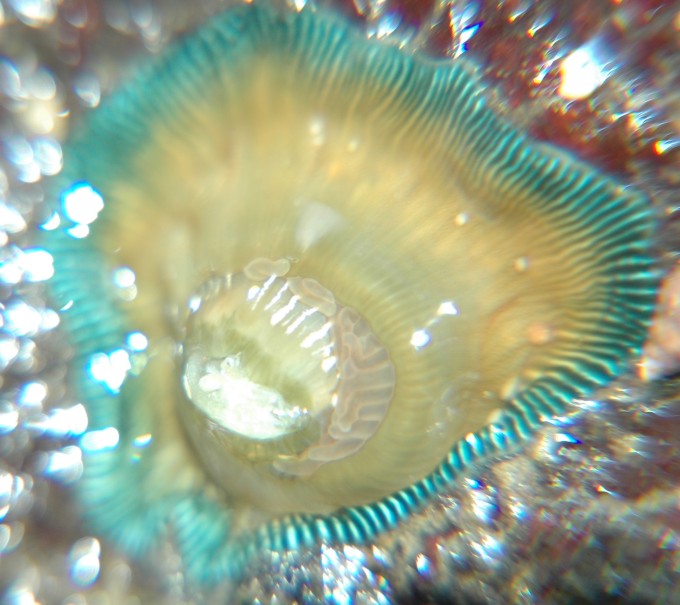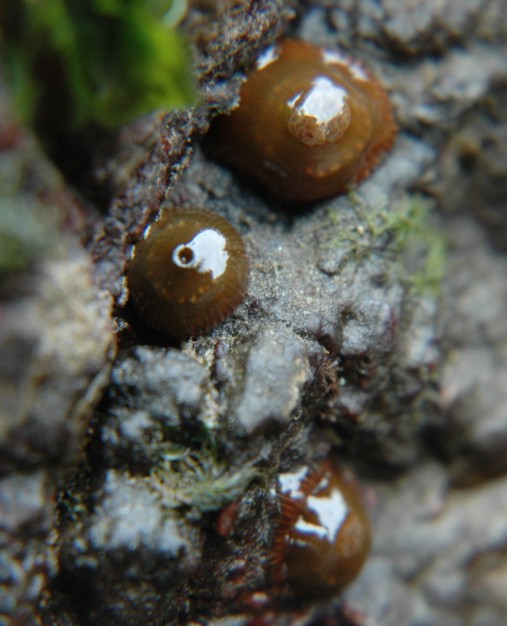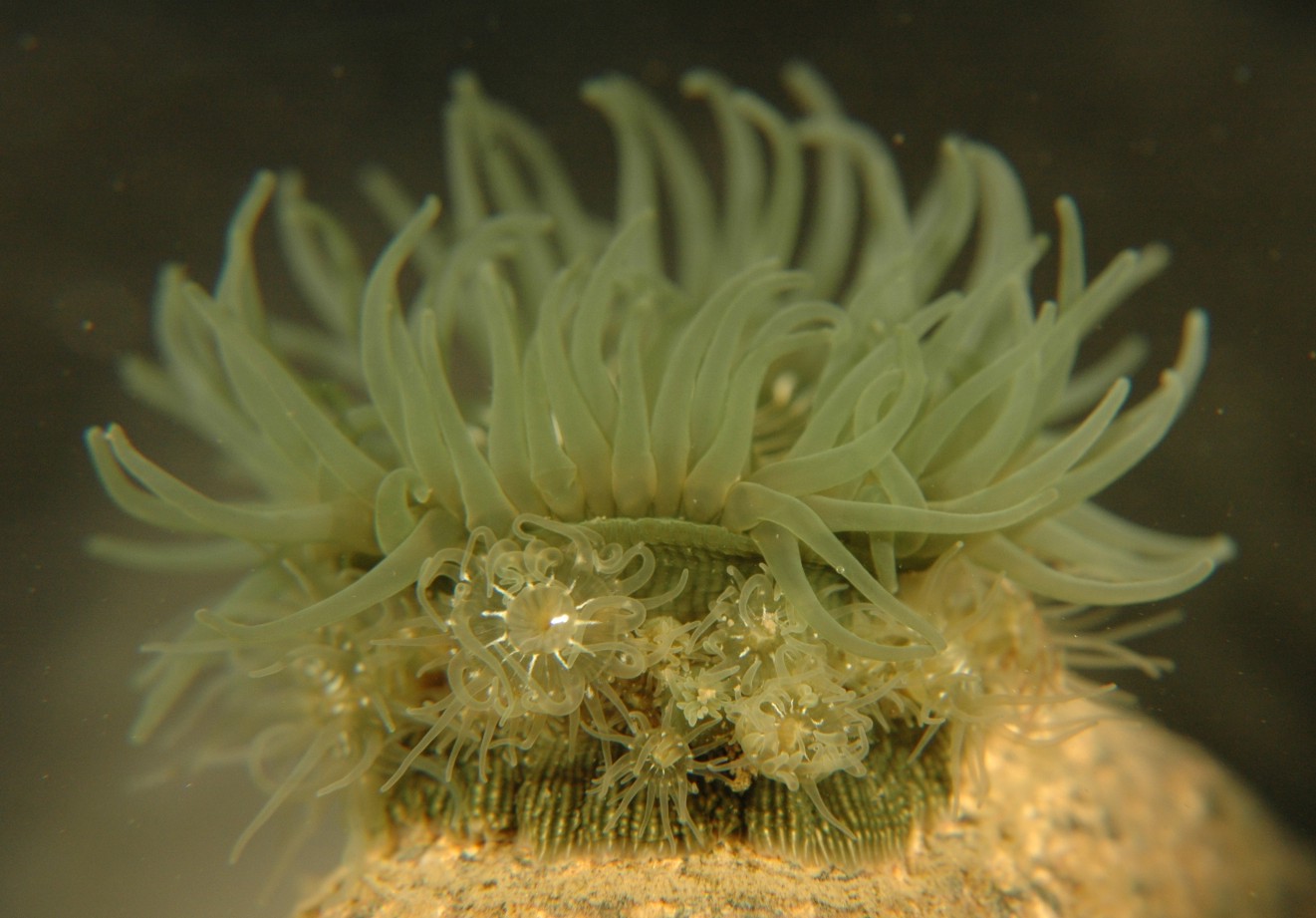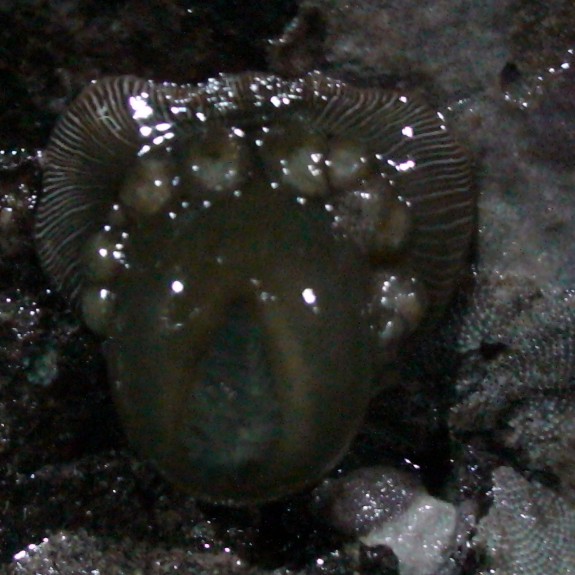Epiactis prolifera Verrill, 1869Common name(s): Brooding anemone, proliferating anemone, small green anemone |
|
| Synonyms: |  |
| Phylum Cnidaria
Class Anthozoa Subclass Zoantharia (Hexacorallia) Order Actiniaria Family Actiniidae |
|
| Epiactis prolifera in an aquarium | |
| (Photo by: Dave Cowles, 2004) | |
How to Distinguish from Similar Species: Epiactis ritteri has broad radiating white lines on the oral disk which do not reach the mouth, breeds young internally, and becomes extremely flat when contracted. E. lisbethae can be up to 8 cm diameter and the radiating dark lines on the edges of the pedal disk extend all the way up to the top of the column. Small individuals which are closed can look similar to E. fernaldi (photo), but look for tiny young of all the same size being brooded on the column (these are of several different sizes when found on E. prolifera and only seasonally).
Geographical Range: Southern Alaska to southern California
Depth Range: Mid intertidal to subtidal
Habitat: On and under rocks and on algae and eelgrass, outer rocky coasts and in bays.
Biology/Natural History: The tentacles of this species end with a terminal pore. Many individuals have tiny juvenile anemones attached near the base. Animals' sexual pattern is gynodioecious (small adults are female, larger adults are simultaneous hermaphrodites), cross-fertilize though some self-fertilization also occurs. Eggs are fertilized inside female gastrovascular cavity, then are expelled. Cilia on the mother's surface move the eggs (or larvae?) down to small pits on the edges of the pedal disk where they attach via mucus and specialized large nematocysts in the mother's tissue. Live on mother's column (digesting yolk, then catching prey) until at least 3 months old and 4 mm diameter, then crawl off. Probably feed on small crustaceans. Predators include nudibranch Aeolidia papillosa and leather star Dermasterias imbricata. Mosshead sculpins may also eat them. Animals move freely about, often pack the bottoms of tidepools, and may be covered with camouflaging debris. Flora and Fairbanks stated they tasted this species' foot fried in butter and do not recommend it even for the desperate.
| Return to: | |||
| Main Page | Alphabetic Index | Systematic Index | Glossary |
References:
Dichotomous Keys:
Flora
and Fairbanks, 1966
Kozloff 1987, 1996
Smith and Carlton, 1975
General References:
Gotshall
and Laurent, 1979
Morris
et al., 1980
Niesen,
1994
O'Clair
and O'Clair, 1998
Scientific Articles:
Edmands,
S. and D. C. Potts, 1997. Population genetic
structure in brooding
sea anemones (Epiactis spp) with contrasting
reproductive modes.
Marine Biology 127: 485-498.
General Notes and Observations: Locations, abundances, unusual behaviors, etc.:

This individual, photographed on San Juan Island, has the blue foot
sometimes seen on this species. Diameter is about 3 cm.
Photo July 2006 by Dave Cowles

Small E. prolifera such as these can look similar
to E. fernaldi
when closed (the radiating lines on the column wall can be faint).
However, notice the tiny, light-colored young being brooded on the
column wall, which would not be seen in E. fernaldi.
Identification by Lisbeth Francis, photo by Dave Cowles on San Juan
Island, July 2006
 |
 |
| This green individual, 3 cm pedal disk diameter, is brooding young of several different sizes. They appear to me to be in more than one row although E. prolifera is supposed to brood them all in one row. Photos by Dave Cowles, July 2007 | The underside of the pedal disk of the same individual does not show any obvious red or orange stripes, as it would if it were Epiactis lisbethae. |

This night shot of an Epiactis prolifera under a
boulder shows
the single row of brooded young.
Photo by Dave Cowles, late October 2007
Authors and Editors of Page:
Dave Cowles (2002): Created original page